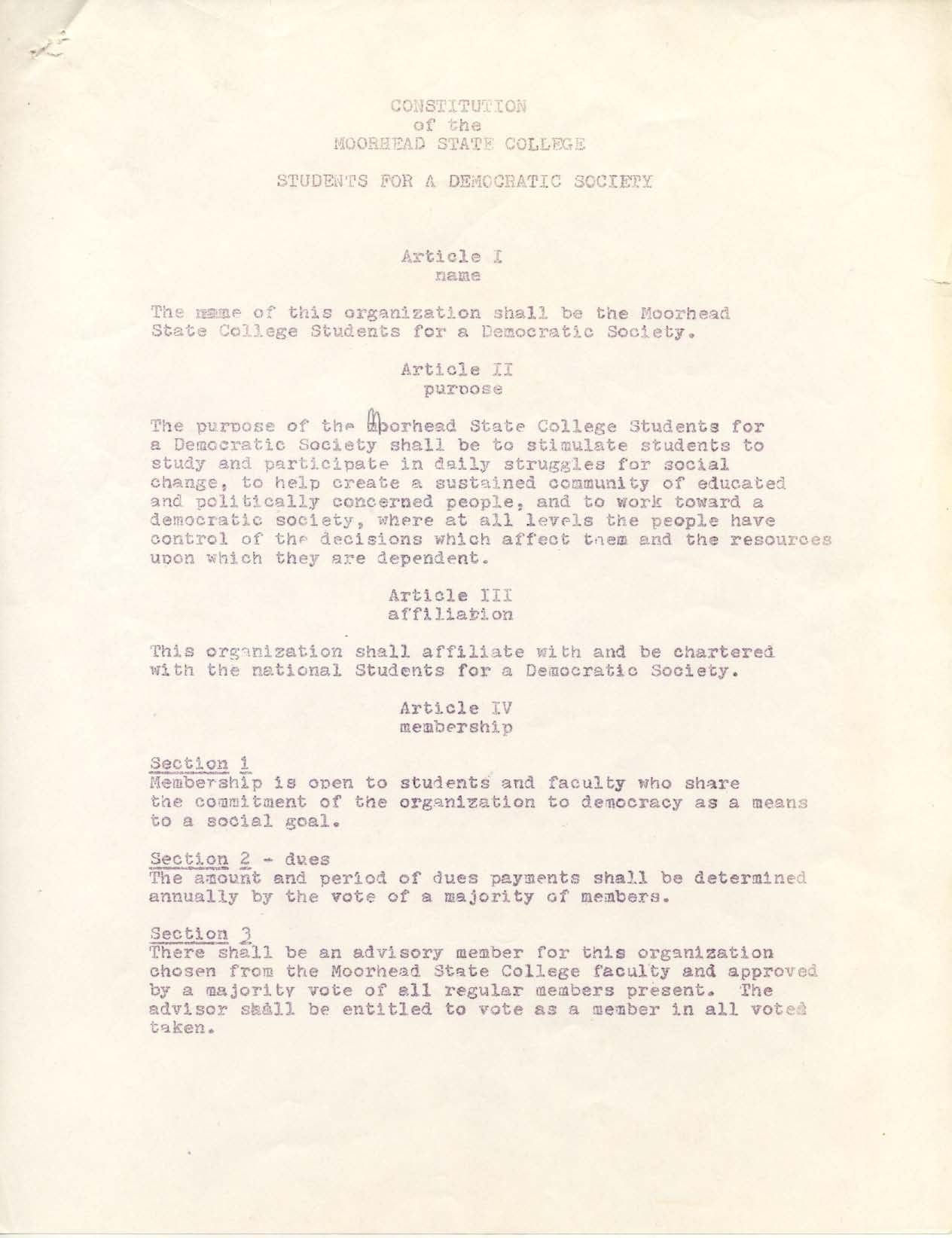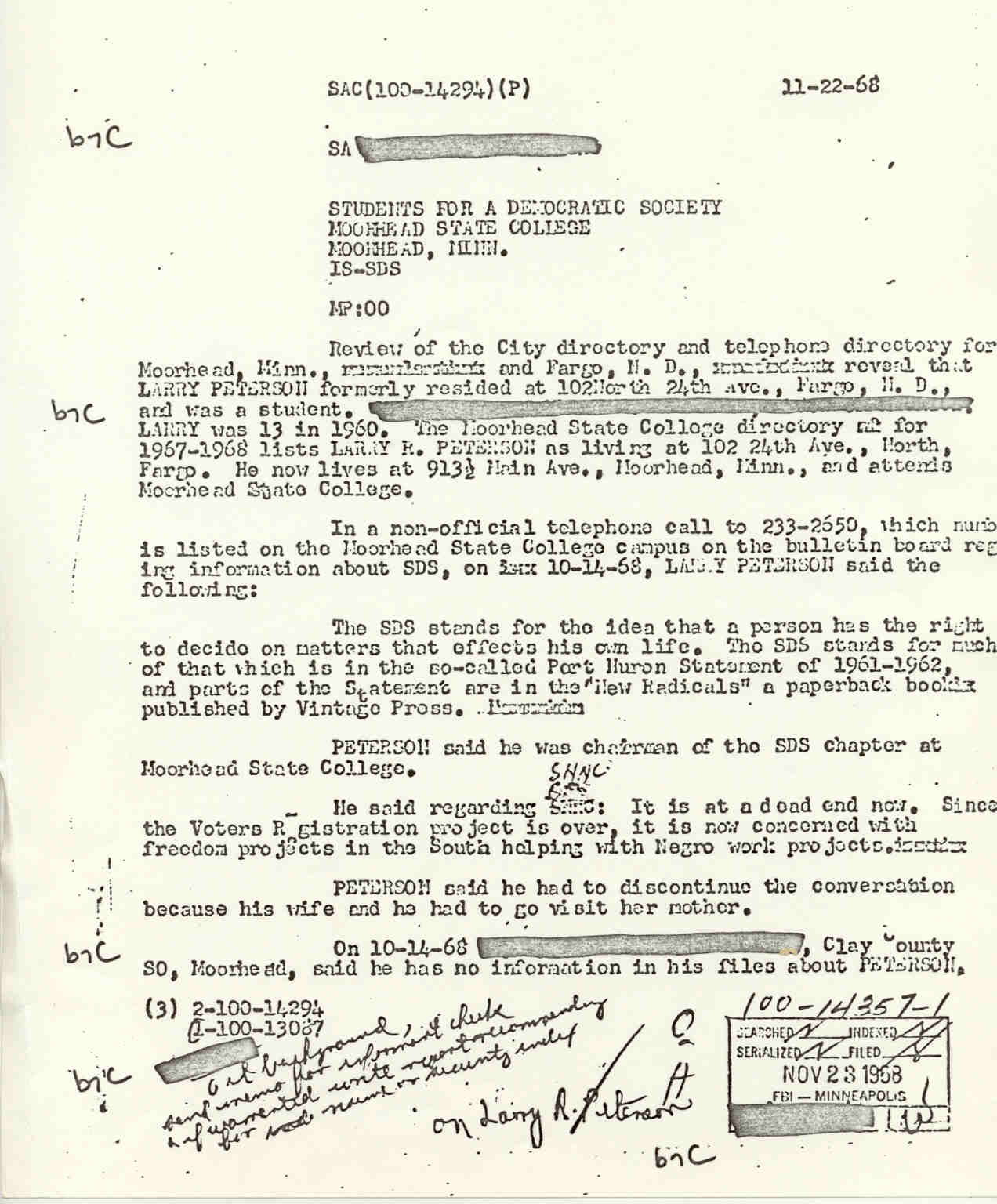

 |
| (read complete text of SCS chapter constitution -- pdf format) |
“Only
the U.S. Civil War rivals the power of the Vietnam War to divide and inflame
generations upon generations of Americans.”
Andreas W. Daum, et al., Introduction to
America, the Vietnam War, and the World
An organized student movement began on the Moorhead State
campus toward mid-decade, later than at some other colleges, but not unusually
late for the Midwest. When
the MSC campus student movement did begin, around 1965-66, it was influenced by
the civil rights movement and by the memory of the late President John F.
Kennedy.
Larry Peterson, who came to MSC in 1966, later recalled Kennedy’s eloquence, his
ability to inspire, as he did
at Amherst College in October 1963, barely a month before his untimely
death: there Kennedy spoke of the need for a powerful United States as a check
against Soviet expansion, but noted as well that a “great future for America”
must be “a future in which our country will match its military strength with our
moral restraint, its wealth with our wisdom, its power with our purpose.”
As a professor
of American history a quarter century later, Peterson admitted that expecting
Americans could somehow consistently balance the necessities of hard power
politics with moral restraint was “somewhat utopian.” But even so, he noted
“utopianism is a key in giving people hope that you really can change things for
the better.”
It was in this hope that eh fondly reminiscence about the student movement on
the campus in the latter part of the 1960s.
“There is something about being in your early twenties, you are more
hopeful that things can be changed.
It made the student movement not as practical as it could have been,
but still something that inspired you to try and change things.”
While some
students at the college had written letters to the
Mistic in support of civil rights for
minorities, and questioning American military support for nations in Latin
America and Asia, there was no organized student movement pursuing these issues
until Joe Bernick, a bright, serious young man whose parents had immigrated to
Israel, organized a
small group and petitioned the school to grant a charter for a campus chapter of
the Students for a Democratic Society (SDS) in the spring of 1966.
The SDS was never very large – Larry Peterson estimated that, while he
was part of the group, no more than fifteen to twenty men and women participated
in SDS activities on a regular basis.
“I’m pleased to say we were not violent in our demonstrations, like in
other areas of the country, and that reflected our upper Midwest values.”
One of the earliest demonstrations Peterson took part ii was at the
Fargo Auditorium.
“It was organized by kids who had gone to another college, and we
joined it. We
sat by the Ten Commandments plaque [where the commandment “thou shalt not kill”
was written] with some signs against war.
People drove past and yelled nasty things at us, but we did it on
Fridays for a couple of months and it was important for us to say that there
were those of us who were opposed to the war in Vietnam.”
 |
| Page from FBI
file maintained on Larry Peterson, 1968 (copy
obtained by Peterson in 1980s). |
The SDS members also felt social pressure to curtail their activities on the MSC campus. In 1967, the Mistic editor suggested that the college consider expelling “the radicals” from the school. More serious – and unknown to Bernick, Peterson, and their fellow members -- the MSC chapter of the SDS had attracted Federal attention: FBI agents were quietly watching them for signs of “subversion,” and filling files with information on each member’s associates and actions. The FBI would continue to monitor the SDS members for some five years. As Larry Peterson learned years later after obtaining access to his FBI file, the agents had done little more than record who he met and talked to, what demonstrations he took part in, and the like; “it hardly made for exciting reading.”